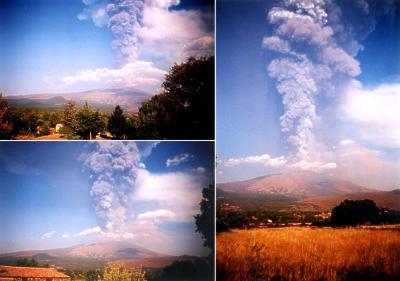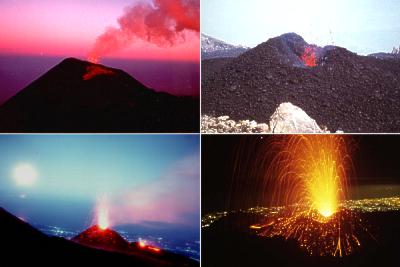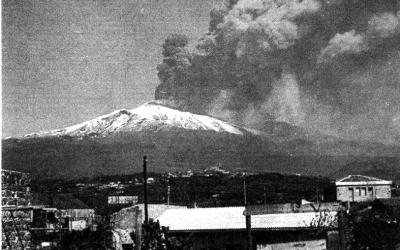 |

Three
spectacular views of a powerful eruption from the Voragine, one of Etna's
summit craters, on 22 July 1998 as seen from Bronte (western side of
Etna). Clicking on the image you will be brought to a page with more
photos of that event
Summit
Eruptions
While
flank eruptions occur at Etna every few years (the longest period without
flank eruptions since 1900 lasted twenty years, from 1951 until 1971,
the shortest only a few months, from June to August 1978), activity
at the summit is nearly continuous. Unfortunately, the historic record
of Etna's activity is dominated by flank activity which was more likely
reported in historic sources due to the greater danger the presented
to the local population and the frequent damage caused by flank eruptions.
Summit activity began to be recorded in a more systematic manner in
the late 1930's and early 1940's in a period without flank eruptions,
but it was only in the late 1960's that summit activity began to be
monitored in a near continuous manner. The need for as complete a documentation
as possible of summit activity was first recognized by Guest (1973)
who was among the pioneers of modern style research on Etna. In his
own words, "summit activity is the pulse of the volcano, and should
be of prime importance in any attempt to understand internal activity"
(John Guest, personal communication).
It is now known that the summit craters are the surface expression of
Etna's central conduit system, through which magma is continuously brought
to the surface from a deep storage area at a depth of about 20-25 km.
The flux of magma may be more or less regular for prolonged periods,
causing mild explosive (Strombolian) activity with slow lava effusion,
known as "persistent" activity, but there are also brief but
highly explosive episodes called "paroxysmal" eruptions which
are among the most spectacular eruptive phenomena to be experienced
on Etna. These two types of summit activity will be discussed in detail
in the following paragraphs.

Various
views of typical persistent Strombolian and effusive activity as observed
at the SE Crater during 1997-1998. By clicking on this image you will
get to the Etna photo gallery with more images depicting this kind of
activity
PERSISTENT
ACTIVITY
The continuous uprise
of magma to the summit craters leads to the type of activity most commonly
observed on Etna, which consists of mild Strombolian bursts (Strombolian
activity, named after Stromboli volcano in the Aeolian Islands, north
of Sicily, consists of discrete explosions sending incandescent bombs
and scoriae tens to hundreds of meters above the vent) accompanied by
the outflow of lava, either from the main vent or from subsidiary vents
on the sides of the main vent. The classic sites of Strombolian activity
on Etna have been, in the 20th century, the Northeast and Southeast
Craters. It is at these two vents that most vertical growth has occurred
at Etna recently, the NE Crater being the highest point on the mountain
between 1978 and 1986 (however, rapid growth has been mostly caused
by paroxysmal eruptions rather than persistent activity). The NE Crater
had three periods of persistent activity which made it a world-famous
type locality for this kind of activity, in 1955-1964, 1966-1971, and
1974-1976. At the SE Crater, a similar period of activity occurred in
1984, and more recently from late 1996 until July 1998. Persistent activity
also occurs within the two larger summit craters, the Voragine (a.k.a.
the Chasm, or "il centrale") and the Bocca Nuova, where this
activity builds small intracrater cones, at times accompanied by the
outflow of small volumes of lava. In 1997-1999, both craters were the
site of intense persistent activity, at times punctuated by episodes
of much more vigorous paroxysmal activity, which led to a gradual filling
of the crater pits to a few tens of meters below their rims.
Generally the output during persistent activity is low, estimated at
less than one cubic meter per second (Chester et al., 1985). Lava flows
do not extend beyond a few hundred meters to several kilometers and
accumulate to form shield-like lava fields while the Strombolian activity
builds cinder and scoria cones on top of these shields. The bulk of
the NE Crater cone grew in this manner, and significant growth of the
SE Cone was caused by the same process. In recent years, the latter
cone experienced a prolonged period of persistent activity which started
in November 1996 and continued without interruptions until late July
1998. During this period the summit crater of the cone formed during
a series of paroxysmal eruptions in early 1990 was filled by lava and
a small intracrater cone, and lava spilled over the crater rim to cover
the flanks on all sides except in the northwest, creating a lava "armor"
tens of meters thick; the overflows did not extend significantly beyond
the cone's base. Both the NE and SE Craters showed a significant change
in their activity after reaching an elevation of more than 3200 m from
persistent mild activity to episodic, short-lived paroxysmal eruptions
which accelerated cone growth.

Press
photo of the paroxysmal eruption at Etna's summit crater in April 1964,
seen from southeast. Click here to learn
more about paroxysmal summit eruptions of 1955-1971
PAROXYSMAL
ERUPTIONS
The most violent
eruptions known from Etna occur at the summit craters. They are characterized
by an unusually high degree of explosivity, and at times are not even
accompanied by lava effusion. A characteristic feature is the formation
of tall eruption columns (at times exceeding 10 km of height) and widespread
ash falls. The term "paroxysmal" eruption was coined by Rittmann
in the 1960's to distinguish these events, which are normally short-lived,
from the long-standing periods of the much milder persistent activity.
Paroxysmal eruptions from the summit craters may be caused by two different
kinds of physical conditions and processes: the arrival of a large batch
of fresh, gas-rich magma (this can also trigger a flank eruption, but
there appear to be periods when the volcano is structurally stable,
preventing the intrusion of magma in fractures away from the central
conduit flanks, and under the flanks of the volcano), and the growth
of a cone in the summit area above a certain elevation.
In the first case, strong degassing of the freshly arriving magma causes
vigorous lava fountaining, tephra emission, and possibly lava flows.
There are lava flows entirely fed by still-molten pyroclastics (spatter,
bombs) falling on the rims and flanks of the erupting crater, so-called
rootless, clastogenic or fountain-fed flows, which have a distinct surface
consisting of huge, brownish blocks. Such flows formed during powerful
paroxysmal eruptive episodes from the Voragine in July 1998 and September
1999. Other paroxysmal eruptions are accompanied by lava flowing from
the base of a lava fountain (such as a small-scale example observed
in June 1998, again at the Voragine, or the voluminous flows that occurred
during the paroxysmal eruptions from NE Crater in 1977-1978, 1980 and
1981). Some of these paroxysmal eruptions appear to have a strong phreatomagmatic
component.
During the past 50 years, paroxysmal eruptions have become much more
frequent, in a period that was also characterized by an increase in
the mean output rate of Etna. In 1960, 1961 and 1964, the Central Crater
was the site of several paroxysmal eruptions (more
detail is available on a separate page). In 1977-1978 about twenty
episodes of violent paroxysmal activity occurred at the NE Crater, building
its cone to 3345 m elevation. These episodes were the continuation of
a phase of activity at the same crater initiated in 1974. Three further
paroxysms in September 1980 and another one in February 1981 raised
the summit of the NE Crater cone to 3350 m, the highest altitude measured
so far at Etna. A series of paroxysmal eruptions marked an early stage
in the life of the SE Crater (in 1978 and 1979), which again erupted
in a similar manner in 1989-1990. These eruptions were probably related
to the rising of fresh batches of magma and rapidly evolved into flank
eruptions as the rise of larger volumes of magma in that crater rapidly
destabilized the volcano and the fracture systems radiating away from
the SE Crater to the east-northeast and southeast. In 1995, episodic
paroxysmal activity returned to the NE Crater with a total of 10 such
events, followed by an isolated paroxysm in late-March 1998. Between
1997 and 1999 more than 10 paroxysmal episodes occurred at the Voragine
and the Bocca Nuova, leading to spectacular and voluminous overflows
of lava from the later onto the W flank of the volcano. However, the
undisputed star among paroxysm-producing craters on Etna in recent years
has been the SE Crater.
From mid-September 1998 to 4 February 1999, this crater was the site
of 22 paroxysmal eruptive episodes. Then, in 2000, it produced 66 (sixty-six)
paroxysms within little more than five months. Never during documented
history has the volcano behaved in a manner as frantic as during these
months: on some days, especially in February 2000, up to three paroxysms
occurred on one single day. In an "encore" to this incredible
show, 16 more paroxysmal eruptive episodes occurred between 9 May and
17 July 2001, but viewed in their context these rather represented the
prelude to another significant eruptive event: the
July-August 2001 flank eruption.
To return to simple numbers, the summit eruptions between 1995 and 2001
produced no less than 120 paroxysmal eruptive episodes. This has to
be compared to about 30 similar events between 1900 and 1971, and about
50 between 1971 and 1993. A dramatically increasing trend is evident,
and this matches with a clear increase in the general productivity of
Etna since 1950, which is expressed also in more frequent and more voluminous
flank eruptions.
SUBTERMINAL
ERUPTIONS
In the classification
proposed by Rittmann (1964, 1973), there appears a type of eruption
called "subterminal", which is closely related to the conduits
that feed the summit craters, and which represents some kind of a hybrid
between summit and (lateral) flank eruptions. For a long time the Northeast
and Southeast Craters were considered subterminal vents, before it became
more common to consider them true summit craters (this was in fact stimulated
by the fact that in the late 1970s the cone surrounding the Northeast
Crater had grown higher than the central summit cone). Yet the concept
of subterminal eruptions is not all that erroneous, because sometimes
activity occurs in the summit area but in locations clearly away from
the summit craters. This occurred, for example, in 1999 at the base
of the Southeast Crater cone. What distinguishes such eruptions from
true flank eruptions is that (a) they usually have lower effusion rates
than flank eruptions; (b) they always show quite low degrees of explosivity,
and (c) they can be followed almost immediately by renewed summit (or
further subterminal) activity. In contrast, flank eruptions are nearly
always followed by months to years of inactivity at the summit, due
to the more complete draining of the central conduit system. However,
there is no clear definition of what can be considered the limit between
subterminal and (lateral) flank eruptions - which might be a given distance
from the summit craters. Furthermore, some major lateral eruptions have
been followed within weeks to months by renewed summit activity, as
in mid-1985 and 1989. And in any case, both subterminal and lateral
eruptions are fed by magma ascending through the central conduit system
of the volcano. Here, subterminal activity is simply treated as summit
activity, as has become common use by nearly all scientists in recent
years.
|



